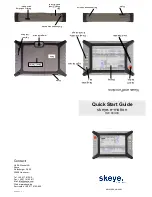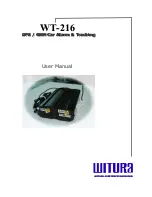
Page 3
SmartOne C User Manual
Confidential & Proprietary Information
9100-0410-01 R2.4
INPUTS
The SmartOne has a multi-functional user interface that provides ground, two dry contact inputs, power and soft-power
down, and serial communication lines.
The SmartOne allows sending Input Status Changed Messages for both Input 1 and Input 2. The Inputs must be asserted
for at least 5 seconds in order to be acknowledged.
Usage Example:
A construction company needs to document, per their contract, when they begin their work day and
when they end their work day. Based on this requirement, the SmartOne would be connected to the ignition switch and
configured to send a transmission with location when the input changes state.
The SmartOne also allows the user to define the Message Interval while the Inputs are in an Undesired State, either
Opened or Closed.
Usage Example:
A company has remote containers at job sites and would like to know if a door is ajar. If a door is left ajar
the company would like a notification every 2 hours. Based on this requirement, the SmartOne would be connected to an
open door sensor with the Undesired Input State Message enabled and set as Opened with a Message Interval of 2 hours.
NOTE:
By default, the SmartOne uses a 5 minute "hysteresis" window to prevent sending false alarms. This means that only
one status change message can be sent during any 5 minute time window. Any subsequent status changes will be detected
but not reported. Multiple status changes during any 5 minute window will result in the transmission of incorrect trigger bits.
Refer to the section for Input Status Changed Message. The Hysteresis may be changed to 0 minutes using the Configuration
Software Program; refer to the Tools Menu Section for details.
The SmartOne has the ability to send an Accumulate/Count Message at a regular configurable interval and/or based on
configurable multiples of accumulated hours and/or number of counted events or hours of vibration.
Usage Example 1:
A construction company needs weekly engine run times for their heavy equipment to manage their
maintenance scheduling. Based on this requirement, the company would schedule a weekly Accumulate/Count Message.
Usage Example 2:
A construction company wants to ensure that no equipment is ever operated beyond 400 hours
without maintenance. Based on this requirement, the company would schedule an Accumulate/Count Message for
every 400 hours of use.
The SmartOne has the ability to send both Status Change and Undesired State messages based on vibration.
SERIAL COMMANDS
The SmartOne uses the multi-functional user interface for unit configuration as well as interface to remote passive and
smart sensors. Two commands are provided in the unit interface to support smart sensors. External sensors or instru-
ments, that can format and communicate with the SmartOne, can send user data through the SmartOne by using these
two commands.
The SmartOne connects to smart sensors via the SmartOne External Input Cable (see Appendix K – External Input Cable)








































